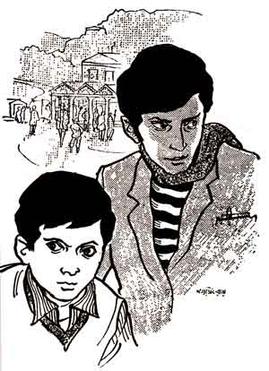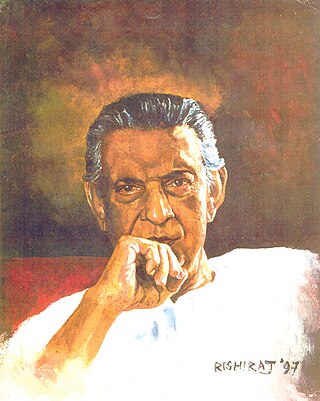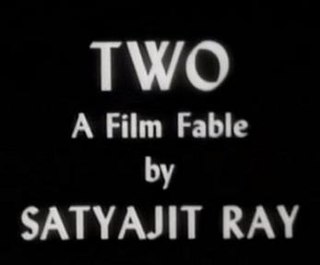Related Research Articles

Feluda, or Prodosh Chandra Mitra [Mitter], is a fictional detective, Private investigator created by famous Indian director and writer Satyajit Ray. Feluda resides at 21 Rajani Sen Road, Ballygunge, Calcutta, West Bengal. Feluda first made his appearance in a Bengali children's magazine called Sandesh in 1965, under the editorialship of Ray and Subhas Mukhopadhyay. His first adventure was Feludar Goendagiri. Feluda is one of the most impactful Bengali characters of time.

Kanchenjungha (Kanchonjônggha) is a 1962 Indian film directed by Satyajit Ray.

Dhritiman Chatterjee is an Indian actor. He began his acting career in 1970 as the protagonist of Satyajit Ray's Pratidwandi. Most of his acting work has been in India's "parallel", or independent, cinema with filmmakers such as Satyajit Ray, Mrinal Sen and Aparna Sen, among others and is noted for his acting skills. He has also worked in English films with well-known filmmakers such as Deepa Mehta and Jane Campion.

Charulata is a 1964 Indian drama film written and directed by Satyajit Ray. Based upon the novel Nastanirh by Rabindranath Tagore, it stars Soumitra Chatterjee, Madhabi Mukherjee and Sailen Mukherjee. The film is considered one of the finest works of Ray.

SoumitraChatterjee was an Indian film actor, play-director, playwright, writer, thespian and poet. He is regarded as one of the greatest and most influential actors in the history of Indian cinema. He is best known for his collaborations with director Satyajit Ray, with whom he worked in fourteen films.

Satyajit Ray was an Indian filmmaker who worked prominently in Bengali cinema and who has often been regarded as one of the greatest directors of world cinema. Ray was born in Calcutta to a Bengali family and started his career as a junior visualiser. His meeting with French film director Jean Renoir, who had come to Calcutta in 1949 to shoot his film The River (1951), and his 1950 visit to London, where he saw Vittorio De Sica's Ladri di biciclette (1948), inspired Ray to become a film-maker. Ray made his directorial debut in 1955 with Pather Panchali and directed 36 films, comprising 29 feature films, five documentaries, and two short films.

Satyajit Ray (1921–1992), a Bengali film director from India, is well known for his contributions to Bengali literature. He created two of the most famous characters in Feluda the sleuth, and Professor Shonku the scientist. He wrote several short novels and stories in addition to those based on these two characters. His fiction was targeted mainly at younger readers, though it became popular among children and adults alike.
Subrata Mitra was an Indian cinematographer. Acclaimed for his work in The Apu Trilogy (1955–1959), Mitra often is considered one of the greatest Indian cinematographers.

Rabindranath Tagore is a 1961 Indian documentary film written and directed by Satyajit Ray about the life and works of noted Bengali author Rabindranath Tagore. Ray started working on the documentary in early 1958. Shot in black-and-white, the finished film was released during the birth centenary year of Rabindranath Tagore, who was born on 7 May 1861. Ray avoided the controversial aspects of Tagore's life in order to make it as an official portrait of the poet. Though Tagore was known as a poet, Ray did not use any of Tagore's poetry as he was not happy with the English translation and believed that "it would not make the right impression if recited" and people would not consider Tagore "a very great poet," based on those translations. Satyajit Ray has been reported to have said about the documentary Rabindranath Tagore in his biography Satyajit Ray: The Inner Eye by W. Andrew Robinson that, "Ten or twelve minutes of it are among the most moving and powerful things that I have produced."

The Inner Eye is a 1972 short documentary film made by Satyajit Ray on Benode Behari Mukherjee, a blind artist and a teacher from Visva-Bharati University, a university founded by Rabindranath Tagore at Santiniketan. The twenty minutes documentary features the life and works of Mukherjee in the form of paintings and photographs, starring himself. The documentary covers his journey from childhood till his blindness along with much of his works and features his words, "Blindness is a new feeling, a new experience, a new state of being". The documentary was awarded as Best Information Film (Documentary) at 20th National Film Awards in 1972.

Sandip Ray is an Indian film director and music director who mainly works in Bengali cinema. He is the only child of the famous Bengali director Satyajit Ray and Bijoya Ray.
Parallel cinema, or New Indian Cinema, is a film movement in Indian cinema that originated in the state of West Bengal in the 1950s as an alternative to the mainstream commercial Indian cinema.

Two: A Film Fable is a 1964 Indian black-and-white short film directed by Satyajit Ray. The film was made under the banner of Esso World Theater at the request of a non-profit American public broadcasting television, PBS. It was made as part of a trilogy of short films from India. The other two films in the trilogy featured Indian Sitar player, Pandit Ravi Shankar and a Ballet troupe from Mumbai, then known as "Bombay". Ray, who worked prominently for Bengali cinema, was requested to make a film in English language with a Bengali setting, however Ray being an admirer of silent film decided to make a film without any dialogue as a tribute to the genre.

Satyajit Ray Film and Television Institute (SRFTI) is a film and television institute located in Kolkata, West Bengal, India. Named after Indian filmmaker Satyajit Ray, the institute provides higher and professional education and technical expertise in the art and technique of film-making and television production. Established in 1995, the institute is an autonomous society funded by Ministry of Information and Broadcasting, Government of India.
The Alien was an unproduced Indian-American science fiction film in development in the late 1960s which was eventually cancelled. It was to be directed by Indian filmmaker Satyajit Ray and co-produced by Columbia Pictures. The script was written by Ray in 1967, loosely based on Bankubabur Bandhu, a Bengali science fiction story he had written in 1962 for Sandesh, the Ray family magazine, which gained popularity among Bengalis in the early 1960s. Bankubabur Bandhu was eventually adapted into a television film by Satyajit Ray's son Sandip Ray, and a play by the theatre group Swapnasandhani Kaushik Sen, in 2006.
The genre of science fiction has been prevalent in the Indian film industry since the second half of the 20th century. Beginning in 1952, the Tamil film Kaadu was made, which was an Indian-American co-production. The 1963 Tamil film Kalai Arasi and 1967 Hindi film Chand Par Chadayee also have science fiction in its storyline. The Alien was a science fiction film under production in the late 1960s which was eventually cancelled. The film was being directed by Bengali Indian director Satyajit Ray and produced by Hollywood studio Columbia Pictures. The script was written by Ray in 1967, based on "Bankubabur Bandhu", a Bengali story he had written in 1962 for Sandesh, the Ray family magazine. In 2018, Tik Tik Tik', Tamil film became the first-ever Indian film that was based mostly in space.

Satyajit Ray was an Indian director, screenwriter, documentary filmmaker, author, essayist, lyricist, magazine editor, illustrator, calligrapher, and music composer. One of the greatest auteurs of film-making, Ray is celebrated for works including The Apu Trilogy (1955–1959), The Music Room (1958), The Big City (1963) and Charulata (1964), Scarecrow.

Cinema of West Bengal, also known as, Bengali cinema or Tollywood is an Indian film industry of Bengali-language motion pictures. It is based in the Tollygunge region of Kolkata, West Bengal, India. The origins of the nickname Tollywood, a portmanteau of the words Tollygunge and Hollywood, dates back to 1932. It was a historically important film industry, at one time the centre of Indian film production. The Bengali film industry is known for producing many of Indian cinema's most critically acclaimed global Parallel Cinema and art films, with several of its filmmakers gaining prominence at the Indian National Film Awards as well as international acclaim.
Feluda is an Indian-Bengali detective media franchise created by Indian-Bengali film director and writer Satyajit Ray, featuring the character, Feluda. The titular character is a private investigator starring in a series of Bengali novels and short stories. The detective resides at 21 Rajani Sen Road, Ballygunge, Kolkata, West Bengal, India. Feluda first made his appearance in a Bengali children's magazine called Sandesh (সন্দেশ) in 1965, under the editorialship of Satyajit and Subhas Mukhopadhyay. His first adventure was Feludar Goendagiri.

Nemai Ghosh was a noted Indian photographer most known for working with Satyajit Ray, as a still photographer for over two decades, starting with Goopy Gyne Bagha Byne (1969) till Ray's last film Agantuk (1991).
References
- ↑ "A tribute to Satyajit Ray on his 99th birth anniversary". The Daily Star. 2 May 2020. Retrieved 3 May 2021.
- ↑ Santi Das (1998). Satyajit Ray, an Intimate Master. Allied. p. 219. ISBN 978-81-7023-748-8.
